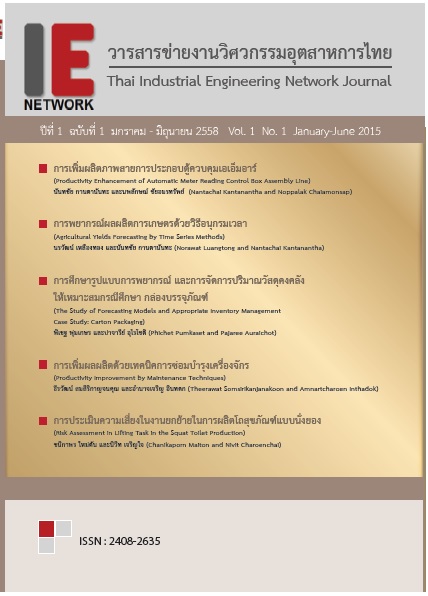การประเมินความเสี่ยงในงานยกย้ายในการผลิตโถสุขภัณฑ์แบบนั่งยอง
Main Article Content
บทคัดย่อ
งานวิจัยนี้มีวัตถุประสงค์เพื่อประเมินความเสี่ยงทางการยศาสตร์ในงานยกย้ายและหาแนวทางการปรับปรุงงานเพื่อลดความเสี่ยง โดยการใช้แบบสอบถามอาการบาดเจ็บจากการทำงานที่ปรับปรุงจากแบบสอบถาม Standardized Nordic และการประเมินท่าทางการทำงานด้วยเทคนิค REBA, การหาแรงกดที่หมอนรองกระดูกบริเวณ L5/S1 และสมการการยกของ NIOSH รวมทั้งวัดอัตราการเต้นหัวใจ (Heart Rate Monitor) ผลจากการประเมินทางการย-
ศาสตร์จากพนักงาน 11 คน พบว่า การประเมินความเสี่ยงด้วยเทคนิค REBA, การหาแรงกดที่หมอนรองกระดูกบริเวณ L5/S1 และสมการการยกของ NIOSH พบว่า ท่าทางการทำงานของพนักงานส่วนใหญ่เป็นงานที่มีการทำงานแบบก้มยก โดยให้ผลการประเมินที่เกินค่าที่กำหนด และผลการประเมินสอดคล้องกับแบบสอบถามอาการบาดเจ็บจากการทำงาน โดยบริเวณหลังให้ค่าความเสี่ยงสูงมากกว่าร่างกายบริเวณอื่นๆ ผลการวัดอัตราการเต้นของหัวใจพบว่า พนักงานส่วนใหญ่มีอัตราการเต้นของหัวใจขณะทำงานในแต่ละงานย่อยมากกว่า 110 ครั้ง/นาที ซึ่งมีความเสี่ยงสูงและอาจทำให้เกิดความล้มเหลวของระบบหมุนเวียนโลหิต งานวิจัยได้เสนอแนวทางเพื่อปรับปรุงงานและเพื่อลดความเสี่ยงทางการยศาสตร์ โดยการปรับปรุงสถานีงานและปรับเปลี่ยนวิธีการทำงานใหม่ รวมทั้งออกแบบอุปกรณ์ช่วยเคลื่อนย้ายถังน้ำดิน ซึ่งใช้หลักเกณฑ์ในการออกแบบให้เหมาะกับสรีระวิทยาของแรงงานไทย
Article Details
บทความ ข้อมูล เนื้อหา รูปภาพ ฯลฯ ที่ได้รับการตีพิมพ์ในวารสารฯ ถือเป็นลิขสิทธิ์ของวารสารฯ หากบุคคลหรือหน่วยงานใดต้องการนำทั้งหมดหรือส่วนหนึ่งส่วนใดไปเผยแพร่ต่อหรือเพื่อกระทำการใดๆ จะได้รับอนุญาต แต่ห้ามนำไปใช้เพื่่อประโยชน์ทางธุรกิจ และห้ามดัดแปลง
เอกสารอ้างอิง
[2] สสิธร เทพตระการพร. 2542. “เออร์โกโนมิคส์ในงานอุตสาหกรรม ปัญหาและการปรับปรุงแก้ไข.” เอกสารวิชาการกองอาชีวอนามัย กรมอนามัย กระทรวงสาธารณสุข 2538.
[3] คะนองยุทธ กาญจนกูล, สราวุธ สุธรรมาสา, จรวยพร ธรณินทร์, จักรกฤษณ์ ศิวะเตชาเทพ และวาริณี เอี่ยมสวัสดิกุล. 2534. เออร์กอนอมิคส์และจิตวิทยาในการทางาน หน่วยที่ 1-5. เอกสารประกอบการสอน สาขาวิทยาศาสตร์สุขภาพ มหาวิทยาลัยสุโขทัยธรรมธิราช.
[4] Brouha, L. 1967. Physiology in Industry. 2nd ed. Oxford: Pergamon Press.
[5] กิตติ อินทรานนท์. 2548. การยศาสตร์(Ergonomics). กรุงเทพฯ: สำนักพิมพ์แห่งจุฬาลงกรณ์มหาวิทยาลัย.
[6] สุทธิ ศรีบูรพา. 2549. เออร์กอนอมิกส์:มนุษยปัจจัย.พิมพ์ครั้งที่ 2. บริษัท ส.เสริม มิตรการพิมพ์ จำกัดกรุงเทพฯ.
[7] คณะกายภาพบาบัด. 2557. การดึงและดันให้
ปลอดภัย.(ออนไลน์). แหล่งที่มา : https://www.pt.mahidol.ac.th/ptclinic/index.php?option=com_content&view=article&id=212%3A-pulling-and pushing&catid=55%3A2009-03-13-03-
23-09&Itemid=111&showall=1.20 กุมภาพันธ์ 2557.
[8] ไวยวิทย์ ไวยกาญจน์, นันทกฤษณ์ ยอดพิจิตร และสรรพสิทธ์ ลิมนรรัตน์. 2556. “การประเมินและปรับ ปรุงทางการยศาสตร์สำหรับงานยกในอุตสาหกรรมไทย.” การประชุมวิชาการข่ายงานวิศวกรรม อุตสาหการ ประจำปี 2556, ตุลาคม.


